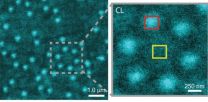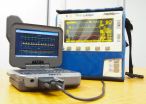In the paper, the team offers a concise evaluation of the potential impact of the evolution of Ebola virus Makona, the strain responsible for the current outbreak, based on genome reconstruction of 25 isolates from Liberia obtained during September 2014-February 2015.
These sequences were consistent with a single virus introduction to Liberia; however, shared ancestry with isolates from Mali indicated at least one additional instance of movement into or out of Liberia, according to senior author Gustavo Palacios, Ph.D., who directs the Center for Genome Sciences at the U.S. Army Medical Research Institute of Infectious Diseases (USAMRIID).
Until now, efforts to sequence the genome of Ebola virus Makona have been hampered by the time it took to send samples back to the United States for analysis, according to first author Jeffrey Kugelman, Ph.D.
"It just wasn't happening fast enough," said Kugelman, a viral geneticist at USAMRIID. "We need answers in days, rather than in weeks or months."
Kugelman recently returned from Liberia, where he spent four months setting up the genomics laboratory at the Liberian Institute for Biomedical Research (LIBR). The laboratory, a collaborative effort between LIBR and USAMRIID, was established to characterize Ebola viral genomes to assess for erosion of diagnostic and therapeutic targets, as well as to provide the scientific and public health communities working in Liberia with viral genomic information.
According to the authors, evaluating changes in the virus in real time is essential to determining whether those changes could have an impact on diagnostics and therapeutics.
"The pace of change is generally consistent with previous estimates of mutation rate," they noted. "Six of the changes we observed are within known binding sites for sequence-based Ebola virus medical countermeasures. However, the diagnostic and therapeutic impact of Ebola virus evolution within Liberia appears to be low at this time."
Palacios said the research team's work would not have been possible without the establishment of the genomic surveillance laboratory in Liberia, emphasizing the need for global sequencing capabilities to be part of the first response during future virus outbreaks.
"It's absolutely essential, with this type of viral infection, to have this capability," said Palacios. "To be able to help establish lines of infection...to be able to look for target erosion in diagnostics and therapeutics...all of these are very important."
USAMRIID's experience with moving laboratory capabilities into a field setting proved invaluable, according to Kugelman.
"We had already established a working relationship with LIBR, thanks to the Ebola virus diagnostics capability that was established by USAMRIID, the Navy and the National Institutes of Health last year," Kugelman said. "And because the diagnostics laboratory is already extracting nucleic acid from patient samples, we knew we would be able to use those isolations to perform our sequencing studies without the need for additional biocontainment considerations."
Several approvals had to be obtained before proceeding with setup, and the team faced numerous logistical challenges in operating the laboratory, Kugelman said. Electrical power must be provided by generators, internet capability is via satellite, and the instrument, an Illumina MiSeq sequencing platform, needs purified water to operate. Kugelman also had to complete a two-week training program to become a certified Illumina technician so he could make needed repairs to the instrument on the spot.
"The sequencing process takes about three days, so a power failure or a fuel shortage can complicate the process even further," Kugelman said. "But it's a fully functional genomics lab--and the fact that we've been able to put next-generation sequencing into the outbreak area has made quite an impact."
Now that the genomics center at LIBR has been established, Palacios said, it will be supporting surveillance projects across the country to investigate reservoir animals and insect vectors of disease to identify potential threats. In addition, the center will support ongoing assessment of samples from patients with severe diseases of unknown origin, providing a key public health asset to West Africa. Key to this transition is Suzanne Mate, Ph.D., who is currently serving as the genomics laboratory lead for USAMRIID in Liberia.
Mate and her colleagues are working closely with public health officials to understand Ebola virus disease transmission, merging epidemiological reporting and genomic surveillance of virus nucleic acids extracted from patient samples in a transmission chain. The newly established genomics laboratory at LIBR has been instrumental in helping to trace the source of Liberia's most recent case of Ebola virus infection, which is reported to be linked to sexual contact with an EVD survivor, as described in an article published May 1 in the Morbidity and Mortality Weekly Report. In response to this case report, the World Health Organization and the Centers for Disease Control and Prevention have recommended consistent condom use by male survivors until additional studies are performed to determine how long Ebola virus is present in body fluids and whether it can be transmitted through sexual contact.
Ebola virus causes severe hemorrhagic fever in humans and nonhuman primates with high mortality rates and continues to emerge in new geographic locations, including West Africa, the site of the largest outbreak to date. Over 26,500 confirmed, probable and suspected cases have been reported in Guinea, Liberia and Sierra Leone, with more than 11,000 reported deaths, according to the World Health Organization.
USAMRIID's mission is to provide leading-edge medical capabilities to deter and defend against current and emerging biological threat agents. The Institute plays a key role as the lead military medical research laboratory for the Defense Threat Reduction Agency's Joint Science and Technology Office for Chemical and Biological Defense. USAMRIID is a subordinate laboratory of the U.S. Army Medical Research and Materiel Command.
INFORMATION:
This work was supported by the Defense Threat Reduction Agency, the Global Biosurveillance Technology Initiative, the U.S. Agency for International Development, and Illumina.
References:
1. Kugelman JR, Wiley MR, Mate S, Ladner JT, Beitzel B, Fakoli L, et al. Monitoring of Ebola virus Makona evolution through establishment of advanced genomic capability in Liberia. Emerg Infect Dis. 2015 Jul. http://dx.doi.org/10.3201/eid2107.150522
2. Possible sexual transmission of Ebola virus--Liberia, 2015. (2015, May 8). MMWR: Morbidity and Mortality Weekly Report, 64(17), 479-481. Retrieved from http://www.cdc.gov/mmwr/preview/mmwrhtml/mm6417a6.htm?s_cid=mm6417a6_w


